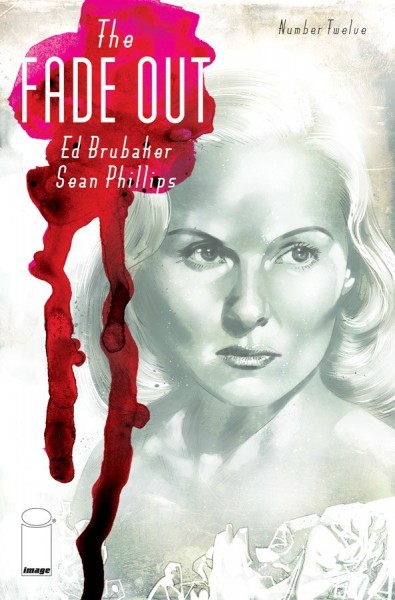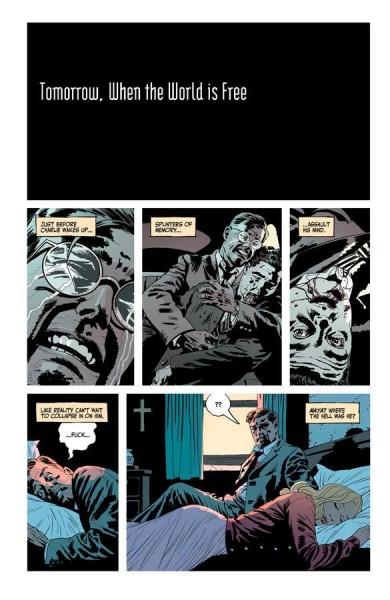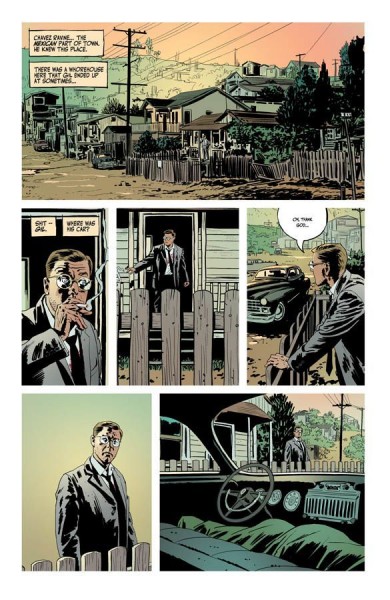The Fade Out #12 Review (SPOILERS)
"The Dead and the Dying"
After twelve issues, Ed Brubaker and Sean Phillips have brought a conclusion to their Old Hollywood saga with
The Fade Out #12. It’s not the usual type of ending chapter, either. Rather than being a plot-driven wrap-up,
The Fade Out #12 is more about the seemingly inevitable demise of someone trying to go against a much greater power. It’s a very powerful comic, which casts the entire series in a thought-provoking and tragic light.

Towards the end of the last issue, screenwriters Charlie Parish and Gil Mason tried to go after one of the heads of Victory Street Studios, whom they believed had a hand in the death of actress Val Sommers. Instead, they found him dead and Gil was shot. In
The Fade Out #12, Gil has died and Charlie has no idea what to do. He stays in a haze with starlet Maya Lopez at her mother’s house while Gil’s body sits in a car outside. Finally, studio fixer Phil Brodsky shows up. Although Charlie believes this mean trouble, but Brodsky knows that Charlie will now fall in the line in return for Brodsky taking care of Gil’s body. Brodsky tells Charlie what he believes happened to Val. However, there is nothing Charlie can do – to get either revenge or justice. He just has to move on.
There are a number of unconventional choices made by Brubaker and Phillips on
The Fade Out #12. They undercut the cliffhanger of issue #11 by starting the issue with Gil Mason already dead. Also, they do eventually get around to giving a sort of explanation of what happened to Val, but it’s not definitive. It’s simply Phil Brodsky’s estimation, and as connected as he is, there isn’t any more evidence here than existed in previous issues. Most series that begin with a murdered character would put a lot of impact into the “who” and the “how.” That’s not the center of
The Fade Out. Here, the exact scenario of the murder, and even the definite murderer, cannot be known. Likewise, there is no solving the case or bringing the guilty to justice here.

In many ways, the ending of
The Fade Out #12 reminded me of the end of one of the great film noirs of all time, the 1972 movie
Chinatown. There is a certain “forget it, Jake. It’s Chinatown” air to the conclusion of
The Fade Out. It’s a defeated acceptance that terrible things can happen, and the central character cannot always win the day. Charlie Parish isn’t even as competent as Private Detected Jake Gittes from
Chinatown. Charlie is just a screenwriter, one who was broken by World War II and returns to America, where he sells out his friends to the Feds to protect himself, thereafter turning into a bitter, alcoholic screenwriter who can’t write anymore.
While Charlie isn’t as bad as some of the
really bad people in
The Fade Out, he’s not a good person. As events occur throughout the series, we see that he repeatedly betrayed his best friend in business and romance. Even the “right” things Charlie does, it’s unclear if he’s doing them for the right reason, or simply out of self-interest and vendettas.

The real criminals in
The Fade Out (there are multiple people guilty of different outrages) are not really punished. Maya Lopez emerges as one of the few characters who seems like a decent person, but she also betrays her original identity as the daughter of a Mexican woman and authenticity by becoming a Hollywood starlet set-up in a sham marriage by the studio with one of their men (who happens to be gay). It’s not that
The Fade Out #12 is saying there is no justice or decency, but rather than it is not common, especially within certain confines with extreme power.
Sean Phillips does a fantastic job on this issue, as he is given a lot of different types of scenes. There are blackout, flash-backs, confrontations and a lot of soul-searching by Charlie Parish. It seems unfair to relegate Phillips’ role to simply artist, as I imagine he and Brubaker work rather collaboratively. Phillips does handle the art side of the storytelling astutely in
The Fade Out #12, though. The semi-imagined sequence in which Brodsky tells Charlie what he believes happened to Val Sommers is very strong.
 The Fade Out
The Fade Out is a very different type of story than those that Brubaker and Phillips have worked on together before, such as
Criminal and
Fatale.
The Fade Out is much shorter, but its impact is not any less. In fact, since the story is told on such a human level (even though it is set in the movie business and involves a murder), I think the overall story of the series is perhaps the best one the pair have told so far. As it is just twelve issues, I think
The Fade Out also becomes a very recommendable story. It’s dark, slow at times, and does not have a happy ending. So it will not be to everyone’s tastes, but it tells a compelling, tragic story (one where the story of most of the major characters are each tragic in their own way just as much as the murder of Val is tragic). There were a few lulls during the series, but overall
The Fade Out is a superb story, and
The Fade Out #12 is a great ending.
Pros
- An unconventional but powerful ending
- Details are revealed about Charlie's misdeeds
- This issue reflects back on the rest of the series in interesting ways
Cons
- It's not the "whodunnit" ending that some readers may crave
 Towards the end of the last issue, screenwriters Charlie Parish and Gil Mason tried to go after one of the heads of Victory Street Studios, whom they believed had a hand in the death of actress Val Sommers. Instead, they found him dead and Gil was shot. In The Fade Out #12, Gil has died and Charlie has no idea what to do. He stays in a haze with starlet Maya Lopez at her mother’s house while Gil’s body sits in a car outside. Finally, studio fixer Phil Brodsky shows up. Although Charlie believes this mean trouble, but Brodsky knows that Charlie will now fall in the line in return for Brodsky taking care of Gil’s body. Brodsky tells Charlie what he believes happened to Val. However, there is nothing Charlie can do – to get either revenge or justice. He just has to move on.
There are a number of unconventional choices made by Brubaker and Phillips on The Fade Out #12. They undercut the cliffhanger of issue #11 by starting the issue with Gil Mason already dead. Also, they do eventually get around to giving a sort of explanation of what happened to Val, but it’s not definitive. It’s simply Phil Brodsky’s estimation, and as connected as he is, there isn’t any more evidence here than existed in previous issues. Most series that begin with a murdered character would put a lot of impact into the “who” and the “how.” That’s not the center of The Fade Out. Here, the exact scenario of the murder, and even the definite murderer, cannot be known. Likewise, there is no solving the case or bringing the guilty to justice here.
Towards the end of the last issue, screenwriters Charlie Parish and Gil Mason tried to go after one of the heads of Victory Street Studios, whom they believed had a hand in the death of actress Val Sommers. Instead, they found him dead and Gil was shot. In The Fade Out #12, Gil has died and Charlie has no idea what to do. He stays in a haze with starlet Maya Lopez at her mother’s house while Gil’s body sits in a car outside. Finally, studio fixer Phil Brodsky shows up. Although Charlie believes this mean trouble, but Brodsky knows that Charlie will now fall in the line in return for Brodsky taking care of Gil’s body. Brodsky tells Charlie what he believes happened to Val. However, there is nothing Charlie can do – to get either revenge or justice. He just has to move on.
There are a number of unconventional choices made by Brubaker and Phillips on The Fade Out #12. They undercut the cliffhanger of issue #11 by starting the issue with Gil Mason already dead. Also, they do eventually get around to giving a sort of explanation of what happened to Val, but it’s not definitive. It’s simply Phil Brodsky’s estimation, and as connected as he is, there isn’t any more evidence here than existed in previous issues. Most series that begin with a murdered character would put a lot of impact into the “who” and the “how.” That’s not the center of The Fade Out. Here, the exact scenario of the murder, and even the definite murderer, cannot be known. Likewise, there is no solving the case or bringing the guilty to justice here.
 In many ways, the ending of The Fade Out #12 reminded me of the end of one of the great film noirs of all time, the 1972 movie Chinatown. There is a certain “forget it, Jake. It’s Chinatown” air to the conclusion of The Fade Out. It’s a defeated acceptance that terrible things can happen, and the central character cannot always win the day. Charlie Parish isn’t even as competent as Private Detected Jake Gittes from Chinatown. Charlie is just a screenwriter, one who was broken by World War II and returns to America, where he sells out his friends to the Feds to protect himself, thereafter turning into a bitter, alcoholic screenwriter who can’t write anymore.
While Charlie isn’t as bad as some of the really bad people in The Fade Out, he’s not a good person. As events occur throughout the series, we see that he repeatedly betrayed his best friend in business and romance. Even the “right” things Charlie does, it’s unclear if he’s doing them for the right reason, or simply out of self-interest and vendettas.
In many ways, the ending of The Fade Out #12 reminded me of the end of one of the great film noirs of all time, the 1972 movie Chinatown. There is a certain “forget it, Jake. It’s Chinatown” air to the conclusion of The Fade Out. It’s a defeated acceptance that terrible things can happen, and the central character cannot always win the day. Charlie Parish isn’t even as competent as Private Detected Jake Gittes from Chinatown. Charlie is just a screenwriter, one who was broken by World War II and returns to America, where he sells out his friends to the Feds to protect himself, thereafter turning into a bitter, alcoholic screenwriter who can’t write anymore.
While Charlie isn’t as bad as some of the really bad people in The Fade Out, he’s not a good person. As events occur throughout the series, we see that he repeatedly betrayed his best friend in business and romance. Even the “right” things Charlie does, it’s unclear if he’s doing them for the right reason, or simply out of self-interest and vendettas.
 The real criminals in The Fade Out (there are multiple people guilty of different outrages) are not really punished. Maya Lopez emerges as one of the few characters who seems like a decent person, but she also betrays her original identity as the daughter of a Mexican woman and authenticity by becoming a Hollywood starlet set-up in a sham marriage by the studio with one of their men (who happens to be gay). It’s not that The Fade Out #12 is saying there is no justice or decency, but rather than it is not common, especially within certain confines with extreme power.
Sean Phillips does a fantastic job on this issue, as he is given a lot of different types of scenes. There are blackout, flash-backs, confrontations and a lot of soul-searching by Charlie Parish. It seems unfair to relegate Phillips’ role to simply artist, as I imagine he and Brubaker work rather collaboratively. Phillips does handle the art side of the storytelling astutely in The Fade Out #12, though. The semi-imagined sequence in which Brodsky tells Charlie what he believes happened to Val Sommers is very strong.
The real criminals in The Fade Out (there are multiple people guilty of different outrages) are not really punished. Maya Lopez emerges as one of the few characters who seems like a decent person, but she also betrays her original identity as the daughter of a Mexican woman and authenticity by becoming a Hollywood starlet set-up in a sham marriage by the studio with one of their men (who happens to be gay). It’s not that The Fade Out #12 is saying there is no justice or decency, but rather than it is not common, especially within certain confines with extreme power.
Sean Phillips does a fantastic job on this issue, as he is given a lot of different types of scenes. There are blackout, flash-backs, confrontations and a lot of soul-searching by Charlie Parish. It seems unfair to relegate Phillips’ role to simply artist, as I imagine he and Brubaker work rather collaboratively. Phillips does handle the art side of the storytelling astutely in The Fade Out #12, though. The semi-imagined sequence in which Brodsky tells Charlie what he believes happened to Val Sommers is very strong.
 The Fade Out is a very different type of story than those that Brubaker and Phillips have worked on together before, such as Criminal and Fatale. The Fade Out is much shorter, but its impact is not any less. In fact, since the story is told on such a human level (even though it is set in the movie business and involves a murder), I think the overall story of the series is perhaps the best one the pair have told so far. As it is just twelve issues, I think The Fade Out also becomes a very recommendable story. It’s dark, slow at times, and does not have a happy ending. So it will not be to everyone’s tastes, but it tells a compelling, tragic story (one where the story of most of the major characters are each tragic in their own way just as much as the murder of Val is tragic). There were a few lulls during the series, but overall The Fade Out is a superb story, and The Fade Out #12 is a great ending.
The Fade Out is a very different type of story than those that Brubaker and Phillips have worked on together before, such as Criminal and Fatale. The Fade Out is much shorter, but its impact is not any less. In fact, since the story is told on such a human level (even though it is set in the movie business and involves a murder), I think the overall story of the series is perhaps the best one the pair have told so far. As it is just twelve issues, I think The Fade Out also becomes a very recommendable story. It’s dark, slow at times, and does not have a happy ending. So it will not be to everyone’s tastes, but it tells a compelling, tragic story (one where the story of most of the major characters are each tragic in their own way just as much as the murder of Val is tragic). There were a few lulls during the series, but overall The Fade Out is a superb story, and The Fade Out #12 is a great ending.